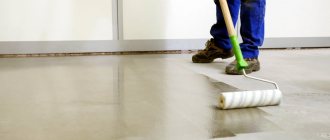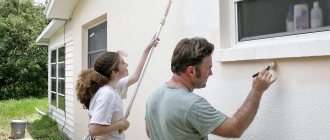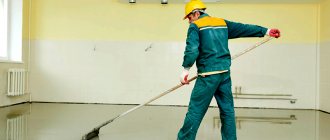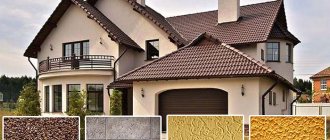Updated: 03/06/2021 12:58:10
Expert: Konstantin Borisovich Polyakov
*Review of the best according to the editors of expertology.ru. About the selection criteria. This material is subjective in nature, does not constitute advertising and does not serve as a purchase guide. Before purchasing, consultation with a specialist is required.
Concrete walls and ceilings are found in many houses and apartments. This durable base can withstand high loads, but has a porous structure. Concrete absorbs large amounts of moisture, which is why the outer layer of the coating often peels off. Therefore, manufacturers of paints and varnishes have created a special series of compositions for painting concrete bases. Today there is a wide selection of concrete paints on the Russian market, so when purchasing, certain difficulties may arise. With the help of our experts, we will try to highlight several of the most important selection criteria.
Painting concrete surfaces - what are the features?
Untreated concrete base is hardened cement, porous and coarse-grained. This texture quickly begins to crumble and become dusty even with minimal impact; when moisture gets in, the concrete breaks down even faster. Water washes out some components of the composition, and at low temperatures freezes in the pores, reducing the strength of the material.
To eliminate these problems, strengthening substances are introduced into the cement mixture, and then additionally stabilized using painting, which eliminates dust, smoothes out roughness, fills the loose structure and protects from moisture, and forms a resistant film that prevents the material from crumbling.
Concrete walls, ceilings, floors, foundations and sidewalks can be painted.
Note! It’s good if the enamel has good hiding power and one layer is enough to completely change the original color of the concrete.
Application methods
Facade paint for concrete for exterior use can be applied using a spray gun. This tool works great when you need to paint a large area. In this case, the composition lies smoothly, and the work can be completed in the shortest possible time.
Among the disadvantages are the costs of equipment, as well as restrictions on some work. For example, it will not be possible to paint a surface with a spray gun in windy weather. If you use a roller, the layer will be much thicker, which indicates a more impressive consumption. The work can be completed in a much longer time if compared with the method described above. Brushes also demonstrate low performance, as well as impressive consumption.
Types of concrete paints that are suitable for interior and exterior work
Concrete paint is selected based on several criteria. The most important is where the work is carried out - outside or inside the premises. For outdoor work, it is important that the material is resistant to low temperatures and UV rays, moisture resistant, dries quickly and looks aesthetically pleasing.
Indoor paint must be safe for health and not contain highly toxic components. For both indoor and outdoor work, the paint should protect the concrete from moisture.
Basic requirements for paint, regardless of where it is used:
- good adhesion,
- vapor permeability,
- abrasion resistance,
- economical consumption.
Classification by composition and type of surface to be painted
To get the desired result, experts recommend paying great attention to choosing the right paint for concrete. There is a lot of different information on the Internet, but there is a standard gradation of materials according to composition and type of surface to be painted.
You can list the main materials by composition:
- Acrylic. These paints are popular not only for concrete surfaces. They contain special polymers and their derivatives, under the influence of which a dense, elastic, breathable film is obtained. Among the advantages of acrylic paints, it is worth noting wear resistance, economical consumption, low price, good hiding power, ease of application, durability of the coating, high drying speed and the ability to use in moderately damp rooms.
- Among the disadvantages, they note the need for careful preparation of the surface for painting, including preliminary priming.
- It is important not to confuse acrylic and alkyd enamels. Alkyd paints are oil paints. They form a hard film on the surface, whose performance properties are worse than those of acrylic compounds.
- Epoxy. They contain epoxy resin and hardener, which must be mixed with a construction mixer to obtain finished enamel. The result is that a waterproof, durable film hardens on the concrete base, which is resistant to any type of impact and retains its appearance for a long time. Therefore, it is often purchased for painting concrete floors. Depending on additional components, the film can be flexible or rigid.
- Among the disadvantages is the possibility of an error in proportions during preparation of the composition.
- Vinyl. These paints create a beautiful matte surface, dry quickly, cover well in one coat, are odorless, environmentally friendly and hypoallergenic. However, now they have almost been replaced by acrylic analogues, since the service life of vinyl coating is no more than 7 years, it is not moisture resistant enough and almost does not “breathe”, which means that concrete deteriorates faster.
- Polyurethane. This is an ideal paint for concrete floors. Particularly resistant to abrasion and mechanical stress. The only negative is the long drying time; complete drying takes up to two weeks.
- Rubber. The consistency is similar to mastic, which after drying resembles rubber. The coating is very durable, but at the same time elastic due to the acrylate latex in the composition. One of the advantages is frost resistance: you can work with paint outside even at -50 degrees. Latex paints are often used on playgrounds and sports fields.
- Water-based. The main component of paint is water, so such materials are non-toxic, easy to wash off, do not smell and are available in a wide palette of shades.
- Silicone emulsion. One of the best offers in terms of its characteristics on the market. It can be used within two days after the concrete has hardened. The enamel forms a completely waterproof, but at the same time “breathable” coating, has high adhesion, is elastic, and wear-resistant. The only drawback is the very high price.
Depending on the surface that is supposed to be painted, there are:
- Concrete enamel for facade. Concrete walls of buildings must be protected from aggressive environmental influences. What is important here is the high penetrating ability of the composition and economical consumption, as well as service life, since repainting building facades is not a very fast and labor-intensive process.
- Foundation paints. Acrylic, polyurethane, epoxy, and silicone compounds are suitable here. When choosing, you need to be guided by the characteristics of concrete and environmental factors. For example, for cold regions, paints based on epoxy resins are used.
- Floor paints. Paints for concrete floors must meet several criteria - resistance to abrasion and mechanical damage, as well as moisture resistance. Polyurethane, acrylic, rubber, epoxy enamels have these properties.
- Materials for painting paving slabs, concrete garden paths and blind areas. The same requirements apply to these paints as to floor paints. But additional attention is paid to protection from precipitation, so acrylic compounds are not suitable here.
Safety precautions
When working with polymer materials, you should use protective equipment against fire and explosion hazards, increased levels of static electricity, and elevated temperatures of equipment and accessories.
The microclimate of the work site must comply with the state standard “General sanitary and hygienic requirements for the air of the working area . The equipment used must ensure maximum mechanization of technological stages.
Work with polymer materials is carried out in isolated rooms with supply and exhaust ventilation. Fume hoods are also installed here for storing paints, impregnations, and primers. Persons at least 18 years of age who have been declared fit after a medical examination and who have undergone full instruction are allowed to work.
The personal safety of each employee is ensured by special clothing , safety shoes, gloves, goggles and respirators. To prevent harmful effects, hands are treated with ointment based on lanolin or petroleum jelly, and washed with soap and water every 2 hours.
How to choose the right paint
To choose a good paint, it is recommended to pay attention to several points.
First you need to assess the intensity of use of the concrete base. For example, to paint walls you will need less wear-resistant enamel than to paint a concrete floor in a garage.
It is important where the painting will be done. For interior work, non-toxic, odorless enamel is required. For outdoor work, resistance to precipitation, UV rays and external damage is important.
Many manufacturers produce universal paints, and before choosing one, you need to carefully study the composition information on the label and recommendations for use.
There is a complete list of requirements for enamels for concrete, however, there is still not a single brand that could combine them all:
- waterproofing properties;
- resistance to low and high temperatures;
- fire resistance;
- health safety;
- neutral smell;
- resistance to physical and mechanical damage;
- ease of care.
Review of popular manufacturers
Tex Profi is a paint for concrete that can be washed. Has relatively low consumption. Cost – 1500 rubles, for 9 liters. It is highly waterproof. The manufacturer has created a product that forms a dense layer with protective properties.
Euro 3 Matt - acrylic paints made on the basis of a copolymer and resin. It is water-based. Consumption – 1 liter per 10 sq.m. Price – more than 2000 rubles. Has high heat resistance.
Flugger Dekso 5. Consumption – 1 liter per 10 sq.m. This paint is completely acrylic, with no other compounds added. Used for painting concrete in the kitchen, office. It is used for decorative purposes and to preserve material.
For painting concrete, the main characteristic when choosing enamel is its protective properties. Decorative coloring and giving the proper appearance come into the background. For interior work, acrylic and silicone enamels are most often used. For external work - rubber, epoxy-based, repair.
Which wear-resistant material should I use for a concrete floor to avoid dust?
When deciding what to paint a concrete floor with, craftsmen recommend paying attention to deep penetration paints. The porous structure of concrete is very fragile and when the partitions between the pores break, the surface begins to gather dust. To avoid this, you need to fill the empty pores with paint, which will give strength to the material and increase its wear resistance.
There are two methods of painting concrete - deep and surface.
With deep coloring, the enamel penetrates deep into the porous structure of concrete, giving it a lasting color and improving the strength and durability of the material. This technology is quite expensive, so surface painting is often used.
Epoxy, polyurethane or rubber are commonly used as wear-resistant paints for concrete floors. Polyurethane can be painted in industrial premises due to its high resistance to mechanical damage.
Note! In order for the paint to adhere well, you must first prime the concrete screed. The use of deep penetration primer and paint will ensure optimal durability of the coating.
Why paint concrete
Despite the progressive development of construction technologies, concrete still remains the most common material. However, this artificial stone has a number of disadvantages, including a porous top layer that is subject to wear and tear and an unsightly appearance.
To ensure an attractive appearance and the longest possible service life, painting becomes one of the simplest, most convenient and affordable solutions . This solution is in demand everywhere and has proven its practical and financial effectiveness.
In addition to protective properties, coloring also imparts decorative qualities to concrete.
Preparing concrete walls for painting
The process of preparing concrete walls for painting consists of several stages.
- Surface cleaning, which may include: removal of old oil paint, removal of mold and dirt. If the concrete is fresh, cement laitance forms on its surface, which must be sanded after the material has dried.
- Removing dust from the surface (you can use a vacuum cleaner).
- If there are cracks and potholes, they are filled with plaster, putty or polyurethane foam.
- After the mixture has dried, the surface is sanded manually or with a special grinding machine and then primed.
Now you can proceed to painting, having previously carried out tinting. To do this, use a white base paint and add pigment.
Scope of application of façade water-based emulsion
Features of using water-based façade paint depend on which surface is being coated with it. This remedy is suitable for many things, but not for everything. In most cases, the water-based emulsion will adhere perfectly:
- on concrete of any type;
- brick;
- stone;
- plastered walls;
- any tree.
It must be borne in mind that the plaster to be painted must be very durable. It is advisable to treat the wooden surface with an antiseptic. By the way, it will “take” a little more paint than others due to its looseness.
Each type of surface has its own “whims,” but there are also general requirements: in most cases, the old layer of paint must be removed before applying a new one; Painting should be preceded by priming, which, in addition to increasing adhesion, will also save on paint consumption.
Under the “curtain”, you can also remember about reliable, proven brands of facade water-based emulsion. These are Eurolux, Admiral, Amphisilan Plus, Tikkurila, Novasil MRC, Yki, Caparol, Dufa, SeidenLatex and others. Russian, Polish and German manufacturers have proven themselves excellent in this regard.
A significant number of people in the modern world choose a water-based emulsion of one type or another to cover their facades. By carefully choosing it, following all the instructions during repair work, as well as the requirements during storage of paintwork materials, you can be sure of an excellent result. The coating will be beautiful, reliable, and durable. You won’t have to think about new renovations for at least the next five years.
Painting technology
Concrete facades are painted deeply or superficially. The first option involves the emergence of chemical processes due to which the compositions are practically eaten into concrete. But the resulting color is durable. Surface painting is used most often because it is the cheapest. The quality of the paint determines how strong and durable the coating will be in the end. Gray is no exception.
The technology for performing the work may have the following description:
- Taping off borders with a type of masking tape.
- They move starting from the top and continuing to the bottom.
- The brush is dipped into the materials so that they evenly cover the tool.
- Continue painting with the same movements.
More attention is paid to the uniform distribution of material over the surface. If there are unpainted areas, then re-application of the composition is required.
The quality of the paint determines how strong and durable the coating will be in the end.











